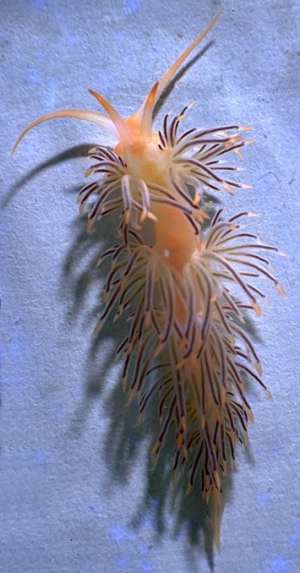
Sakuraeolis gujaratica
Rudman, 1980
Order: NUDIBRANCHIA
Suborder: AEOLIDINA
Family: Glaucidae
DISTRIBUTION
Known only from North-western India.
PHOTO
Holotype, 30 mm long alive. Adatra, Okha, Gulf of Kutch, Gujarat State, India. 10 June, 1971. AM C111478. Photo: Bill Rudman.
The body is pale orange, elongate but reasonably broad with a prominent pericardial swelling. The foot is colourless. The basal half of the rhinophores and basal third of the oral tentacles are translucent whitish, the rest of both being orange. The tips of the rhinophores are an intense orange. The oral tentacles are long and slender, the rhinophores being about two-thirds their length and having a slightly wrinkled appearance. The cerata are arranged in eight groups down each side of the body. The first five groups are on slightly raised pads, forming multi-rowed rounded arches. The posterior three groups consist of irregular clusters of a few cerata. The cerata are long and slender, and are usually held out from the body. The ceratal wall is translucent and colourless except for the tip which is tinged with orange. The deep wine or purplish ceratal digestive gland duct is visble throught the ceratal wall. Three small groups of cerata are found at the posterior end.
-
Rudman, W.B. (1980) Aeolid opisthobranch molluscs (Glaucidae) from the Indian Ocean and the south-west Pacific. Zoological Journal of the Linnean Society, 68: 139-172.
Rudman, W.B., 2004 (December 28) Sakuraeolis gujaratica Rudman, 1980. [In] Sea Slug Forum. Australian Museum, Sydney. Available from http://www.seaslugforum.net/find/sakuguja
Related messages
Re: Sakuraeolis gujaratica from type locality
February 17, 2010
From: Dishant Parasharya
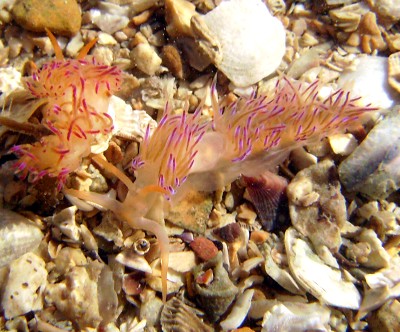
Concerning message #22437:
Dear Dr. Bill,
In January 2010 trip to Poshitra I found 12 individuals, feeding on hydroids at Poshitra reef. As it is a Marine Protected Area since 1982, the collection of specimen is banned. We first recorded the species in November 2009. However the density of this species seems to be high during winters, where the water temperature is 20 degree C. The hydroid species found on this particular reef area seems to be unique.
Locality: Patchy reef, 15 cm, Gujarat, India, Gulf of Kutch, 12 January 2010, Intertidal rockpool. Length: 28 mm. Photographer: Dishant Parasharya.
Thanks
Dishant
dparasharya@gmail.com
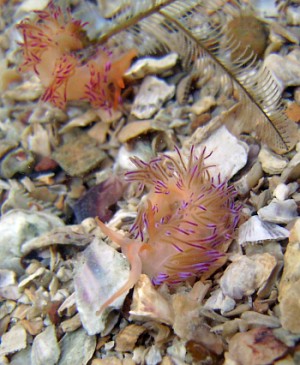
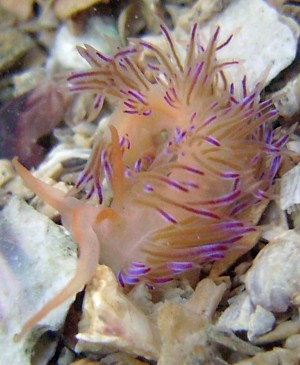
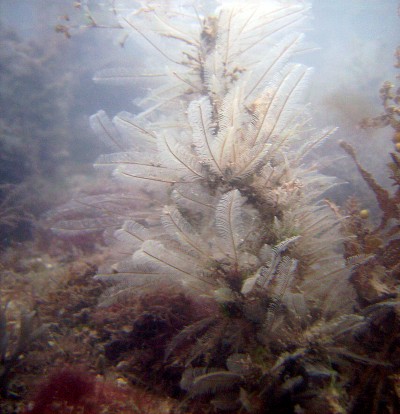
Dear Dishant,
It is good to get some more records of this rarely reported species
Best wishes,
Bill Rudman
Sakuraeolis gujaratica from type locality
May 7, 2009
From: Apte Deepak
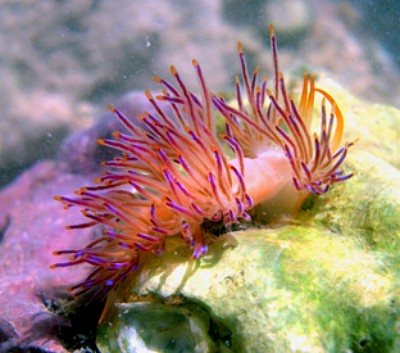
Concerning message #12829:
Dear Dr. Rudman
On 26th April 2009 we managed to collect three specimens of Sakuraeolis gujaratica from the type locality. We got one specimen in February as well. This note is just to share with you the news since the species was described by you from this locality
The species seemed to occur from January till April (when we surveyed last) and mostly seen on hydroid with pink coloured polyps. I am also attaching the image of hydroid which we collected along with the
specimen.
Locality: Adatra, Poshitra, exposed reef, Gujarat, Arabean Sea, 26 April 2009, Reef. Length: 30 mm. Photographer: Deepak Apte.
Deepak Apte
Bombay Natural History Society
Mumbai, India
spiderconch@gmail.com
spiderconch@gmail.com
Apte D.A., 2009 (May 7) Sakuraeolis gujaratica from type locality. [Message in] Sea Slug Forum. Australian Museum, Sydney. Available from http://www.seaslugforum.net/find/22437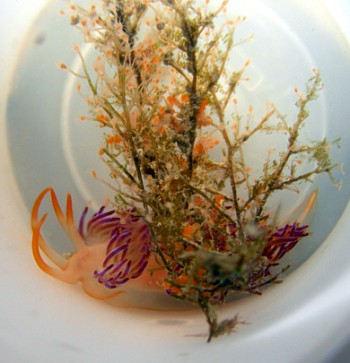
Dear Deepak,
Thanks very much. This brings back memories of my time in NW India nearly 40 years ago. I was very short of film so could only spare two shots for this species - fortunately, as you can see on the Fact Sheet, one of them worked. I know of no other finds of this species so your photos are a valuable addition to our knowledge of the species and its colour. Hopefully the hydroid will be identifiable from its colour. It is interesting to speculate that the amount of orange pigment in the skin of the aeolid may depend on whether it is feeding on this hydroid or not.
Best wishes,
Bill Rudman
Two more species of Sakuraeolis
December 28, 2004
From: Bill Rudman
To accompany Denis Riek's message on Sakuraeolis nungunoides, here are Fact Sheets on two further species of the genus:
Sakuraeolis gujaratica
Sakuraeolis kirembosa
Best wishes,
Bill Rudman
Rudman, W.B., 2004 (Dec 28) Two more species of Sakuraeolis . [Message in] Sea Slug Forum. Australian Museum, Sydney. Available from http://www.seaslugforum.net/find/12829
